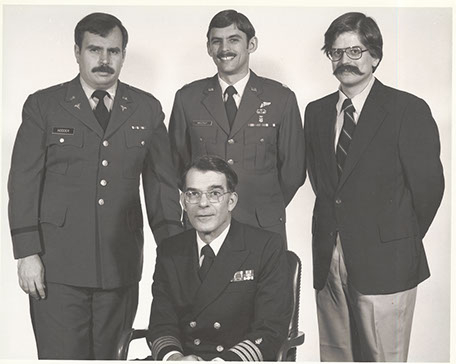OUR ORIGINS STORY
It was 1976, the university had been established, and a seasoned U.S. Navy Captain who had spent more time in the fields of southeast Asia than a classroom was named as the first Chair of the Department of Preventive Medicine and Biometrics, one of the original departments of the university. Captain Peter Franz Dirk Van Peenen, who was both a Preventive Medicine Physician and research scientist (PhD in mammology) was a leading tick-borne and arboviral disease expert of the time and was called back to the confines of polished floors of academia to launch a department to train the future generations of physicians and researchers in uniform. By the end of 1979 the department had grown to a total of four faculty, including U.S. Army LTC Richard Hodder, a Preventive Medicine Physician and Nephrologist, Air Force Maj Terry Angstadt, a flight surgeon and the first full-time billeted civilian faculty, Dr. David Cruess who to the present day is Professor and Vice Chair for Graduate Programs and has taught the core Biostatistics I class to every graduate student since 1978.
The Department’s genesis set in motion the qualities of an institution that are still with us today. To this day we thrive on diversity—diversity of expertise, of Service, of specialty, of career path—to create an environment rich with variety of ideas, perspectives on problem solving, and focus on the relevance of teaching to the Service member. Furthermore, the focus on the importance of the fundamentals of data to drive the effectiveness of our graduates is as true today as it was in the beginning when Dr. Hodder was one of the earliest adopters of microcomputing (an Apple II that may still be found somewhere in halls) and the first choice for a billeted civilian faculty biostatistician. There was an early recognition, that despite those foretelling that the era of infectious disease was falling on the horizon, we had to make a commitment and resolve that for the deployed soldier, sailor, airman, marine and coastie, guarding against the impact of infectious disease would always be a priority.
While we are now one of the largest departments in the School of Medicine with over 60 billeted faculty and staff, these core values of embracing diversity and interprofessional exchange, a fundamental focus on data driven public health decision making, and a commitment to be guardian against infectious disease remain as true today as they were 42 years ago.

